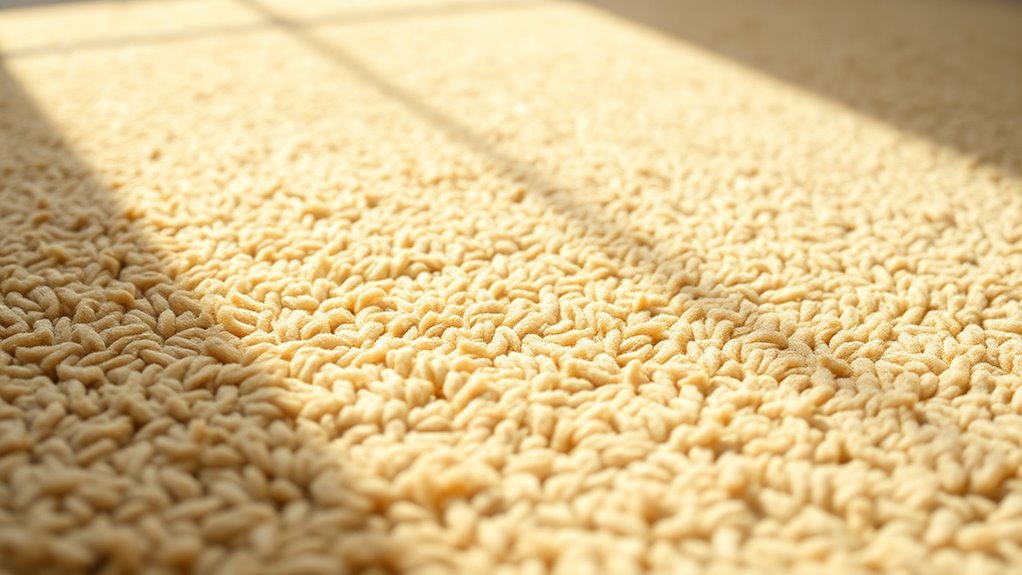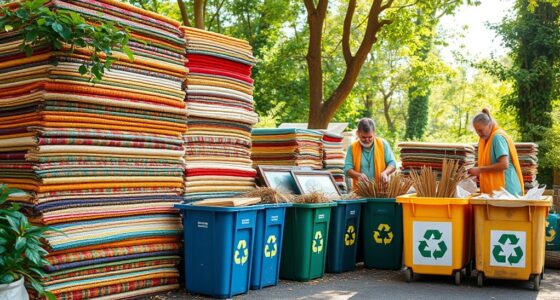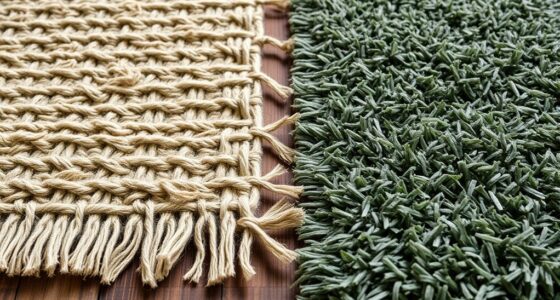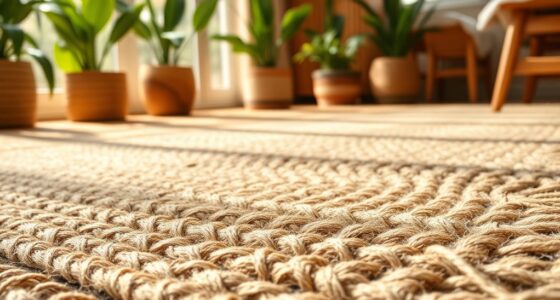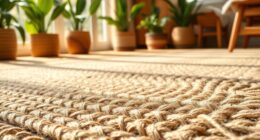Choosing low-VOC rug finishes helps improve your home’s air quality by reducing harmful emissions and chemical exposure. These eco-friendly options use natural oils, water-based formulas, and renewable resources, supporting sustainability and a healthier environment. Proper application techniques and good ventilation maximize their benefits. By prioritizing these finishes, you create a safer, cleaner space for you and your family. Keep exploring to discover more ways to make your home even healthier.
Key Takeaways
- Low-VOC rug finishes improve indoor air quality by reducing harmful emissions and chemical odors.
- Using natural, water-based, or plant-based finishes supports healthier living environments.
- Proper application techniques ensure even coverage, durability, and minimal VOC release.
- Preparing rugs thoroughly and choosing compatible finishes promote better adhesion and safety.
- Applying finishes in well-ventilated areas minimizes residual fumes, enhancing indoor air safety.
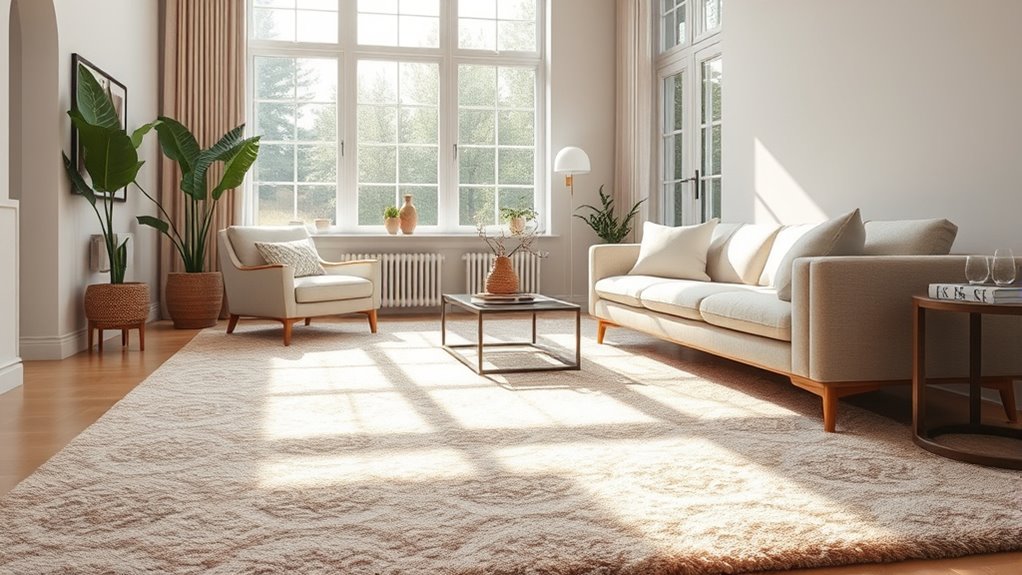
Choosing low-VOC rug finishes is a smart way to enhance your indoor air quality while protecting the environment. When selecting finishes, you’ll want to focus on those made from sustainable materials, which are designed to minimize harmful emissions and reduce your carbon footprint. These eco-friendly options often use natural oils, plant-based resins, or water-based formulas instead of traditional solvent-based chemicals that release volatile organic compounds into your home. By opting for such finishes, you’re not only creating a healthier living space but also supporting sustainable practices that prioritize the planet’s well-being.
Opt for sustainable, low-VOC rug finishes to improve air quality and support eco-friendly practices.
Application techniques play a vital role in guaranteeing that low-VOC finishes perform well and last long. Proper application methods, such as using airless sprayers or brushes designed for delicate surfaces, help you achieve an even coat without excess waste or overspray. Applying thin, uniform layers allows the finish to cure properly, reducing the risk of peeling or uneven coloration. It’s essential to follow manufacturer instructions carefully, including drying times and environmental conditions, to maximize the durability of the finish. Good application techniques also minimize the release of VOCs during and after the process, further safeguarding your indoor air quality.
When working with sustainable materials, you’ll notice they often require specific preparation steps, such as cleaning the rug thoroughly before applying the finish to guarantee proper adhesion. Some finishes are designed to penetrate deeply into fibers, providing a protective barrier without creating a thick film that could trap dust or allergens. This enhances not just the appearance but also the overall safety and hygiene of your rug. Additionally, choosing finishes that are low in VOCs makes routine maintenance easier, as they emit fewer odors and pollutants over time.
You might also consider how environmental factors influence application techniques. For example, applying finishes in well-ventilated areas helps dissipate any residual fumes, even if they are low-VOC. Proper ventilation is particularly important when working with natural or water-based finishes, which tend to have minimal odor and VOC emissions. When you combine the right sustainable materials with proper application techniques, you guarantee a cleaner, healthier environment for everyone in your home. These choices contribute to safer indoor air quality, reduce exposure to harmful chemicals, and promote a more sustainable lifestyle overall.
Frequently Asked Questions
Are Low-Voc Rug Finishes as Durable as Traditional Options?
Low-VOC rug finishes are generally as durable as traditional options, but durability concerns can vary based on the specific product and application. You might find they cost a bit more upfront, but they often last longer and maintain their appearance better over time. When comparing costs, consider the health benefits and potential savings from better indoor air quality. Overall, they provide a sustainable, long-lasting choice for your home.
How Quickly Do Low-Voc Finishes Off-Gas After Application?
After application, low-VOC finishes typically off-gas within a few days to a week, depending on environmental conditions like temperature and ventilation. During this period, the air quality impact is minimal but still worth monitoring. To speed up off-gassing and improve air quality, make certain of good airflow and ventilation. You can usually resume normal activities quickly, knowing that low-VOC finishes are designed to emit fewer harmful chemicals for your health and home.
Can Low-Voc Finishes Be Used on All Rug Types?
You can generally use low-VOC finishes on most rug types, but it’s important to check rug compatibility before applying. Some delicate or specialty rugs may require specific finishes or treatments to avoid damage. Always follow the finish application instructions carefully, ensuring the product is suitable for your rug’s material. Testing a small area first helps confirm compatibility, so your rug remains safe and vibrant after finishing.
Are Low-Voc Rug Finishes More Expensive Than Standard Finishes?
Low-VOC rug finishes are often a bit more expensive than standard ones, like paying a premium for quality. You might notice the cost comparison, but consider the environmental impact—these finishes reduce harmful emissions and support healthier indoor air. While they may cost more upfront, they contribute to a cleaner, greener home environment. So, investing a little extra can pay off in long-term health and sustainability benefits.
Do Low-Voc Finishes Require Special Maintenance or Cleaning?
You don’t need special maintenance or cleaning for low-VOC rug finishes, but following proper cleaning routines and maintenance tips helps preserve their benefits. Use gentle cleaning products and avoid harsh chemicals to protect the finish. Regular vacuuming and prompt stain removal keep your rug looking fresh. These simple steps guarantee your low-VOC finish remains effective, maintaining a healthier home environment and cleaner air without requiring extra or specialized upkeep.
Conclusion
Choosing low-VOC rug finishes not only benefits your home’s air quality but also creates a healthier environment for you and your family. As you walk across your new, fresh-smelling rug, you might notice how the cleaner air feels lighter and more inviting. It’s a small change that coincidentally brings a big difference—making your home safer and more comfortable without sacrificing style. In the end, healthier living starts right beneath your feet.
